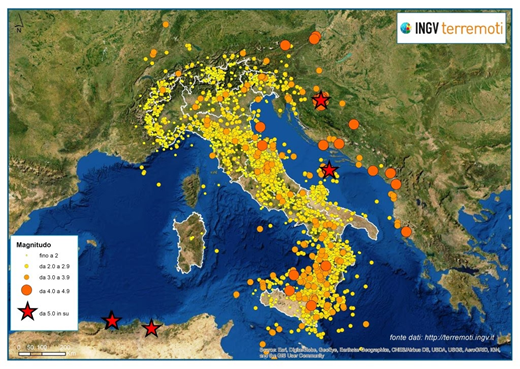In 2021, the average of 44 earthquakes per day localized by the 24-hour surveillance rooms of the INGV confirmed: almost 1 earthquake every 30 minutes.
In the “Special earthquakes 2021” of the INGVterremoti Blog, you can “navigate” among the seismic events with interactive maps and infographics.
16,095 are the earthquakes in Italy and in neighboring areas located by the National Seismic Network in 2021: an average of 44 earthquakes per day, or on average one event every half hour.
“The trend of the last three years was also confirmed in 2021, with the strongest earthquakes located outside the Italian territory“, says Alessandro Amato, INGV seismologist. “As can be seen from the map published on INGVterremoti, the seismic events that recorded a magnitude equal to or greater than 5.0 took place in Algeria, Croatia, and the Adriatic Sea, even if some of them had a resentment also in the Italian territory“.
“On January 6, 2021”, continues Amato, “an earthquake of magnitude 5.2 occurred a few kilometers from Petrinja in Croatia, connected to the seismic sequence that began at the end of 2020 with an earthquake of magnitude 6.3 on December 29 in the same location. Furthermore, on March 18, 2021, two earthquakes of magnitude 6.2 and 5.3 were recorded on the coasts of Algeria. For the first Algerian earthquake, the INGV Tsunami Warning Center (CAT-INGV) issued an orange level tsunami warning for the coasts of Algeria near the epicenter and an information message for the other coasts of the Mediterranean Sea, Italy including. The last days of March were characterized by the seismic sequence in the central Adriatic, which began on 27 March with the 5.2 magnitude earthquake located about 80 km from the coast of Gargano Puglia and about thirty kilometers from the Croatian island of Lastovo“.
The number of earthquakes located in Italy in 2021 is slightly lower than in 2020 and has remained stable since 2019. Numbers lower than those recorded in the years 2016-2017-2018, characterized by the seismic sequence in central Italy. The contribution of this sequence that began on 24 August 2016, in terms of the number of events, is however important also in 2021, representing about 30% of the total seismicity in Italy.
“The first Italian earthquake of 2021 occurred in the Modena area, in Pavullo nel Frignano, 1 hour and 3 minutes after the start of the new year. The last one, however, we located in Sefro, in the province of Macerata, less than half an hour from midnight: both recorded a magnitude of less than 2.5” explains Maurizio Pignone, a geologist at INGV. “Sardinia is confirmed as the region with the lowest number of earthquakes, while Sicily has had over 80 events with a magnitude of 2.5 or greater, more than all other regions. However, if we also counted very small earthquakes, the primacy would be conditioned by the density of the seismic network and Marche and Umbria would ‘win’ with approximately 3,000 and 5,000 events respectively”.
The strongest earthquake occurred in Sicily, near Motta Sant’Anastasia (CT), on 23 December 2021, within a seismic swarm with over 50 events within three days and was characterized by a magnitude 4.3. The smallest, however, was recorded near Gubbio (PG) on 13 August 2021 with a magnitude which, in this case, was 0.0, located by the National Seismic Network in an area of Italy where the sensitivity of the network is maximum.
The earthquakes of 2021 are “navigable” with the interactive map and with a “dashboard” story map created by the INGVterremoti Team.
“With the dashboard, you can navigate through all the 2021 earthquakes on an interactive map and interrogate each earthquake to view the related hypocentral parameters” highlights Maurizio Pignone, “Furthermore, with the infographics the public interacts with the map, selecting the areas and displaying information on the maximum magnitude, on their distribution in the 12 months of the year and much more“.
“The graphic representation of the seismic events that occurred in Italy is a fundamental tool that the INGV makes available to citizens and the scientific community to increase awareness of the fragility of our territories throughout the peninsula, as well as providing a research tool for scholars from all over the world. Despite the persistence of the pandemic, the seismic surveillance carried out by the INGV did not stop, not even for a second. Awareness of the nature of our territory, its seismicity and its geological conformation is an informative activity that the Institute constantly pursues with continuous research and monitoring dissemination actions such as the Seismic Literacy Day promoted by INGV in the month of January of each year: the Earth is a living planet, Italy will always continue to have earthquakes and we must invest in their greater knowledge to better defend ourselves in the future”, concludes prof. Carlo Doglioni, President of INGV.







